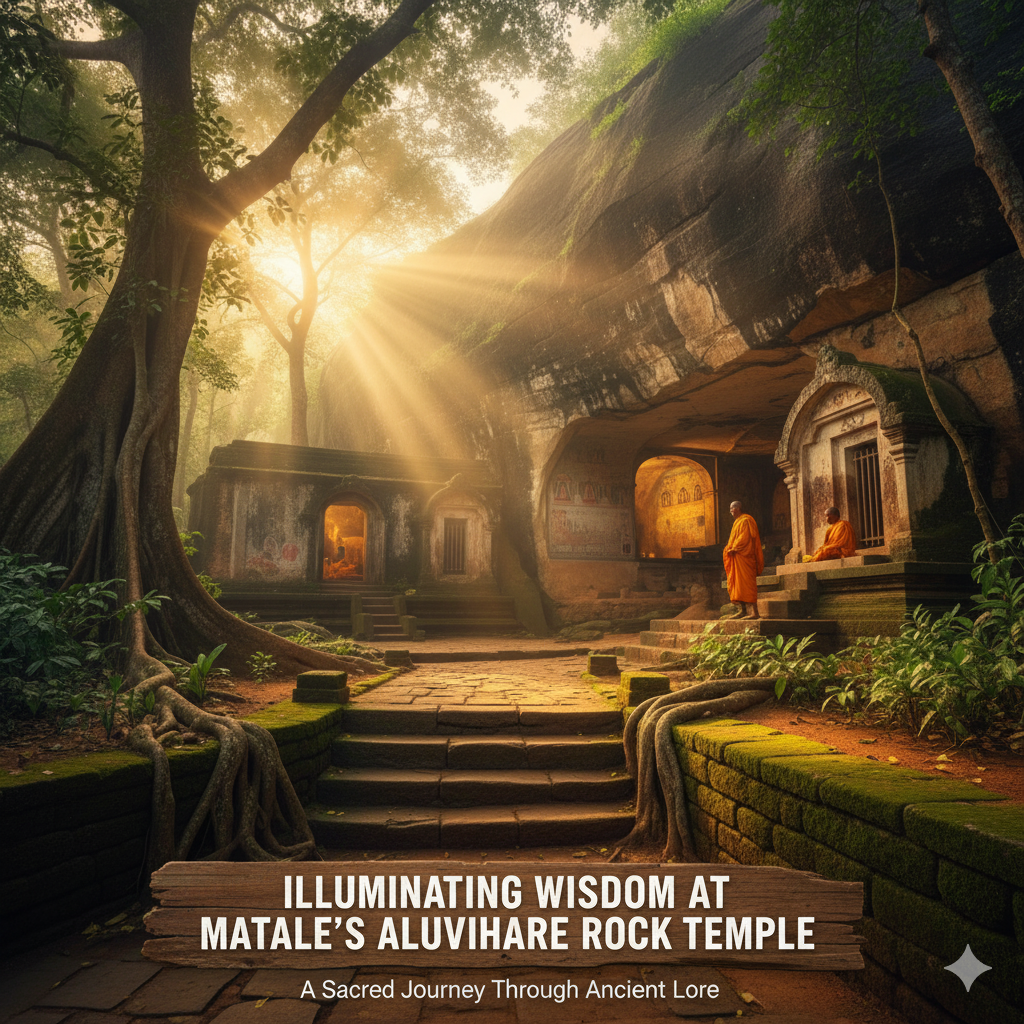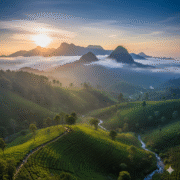
Illuminating Wisdom at Matale’s Aluvihare Rock Temple
- November 13, 2025
- eunoialankatours
- 6:05 pm
The Aluvihare Rock Temple (Matale Alu-Viharaya) is not only a religious site; it is also the birthplace of Sri Lanka’s written Buddhist tradition. It is located in the Wiltshire Mountains north of Kandy. The name gives away what it is: Aloka in Pali and Alu in old Sinhala both indicate “light.” Viharaya is the name for the homes of monks. It is said that the caves used to be called Aloka-Lena, which means “caves of light,” because sunlight still came through the rocks. No matter where it came from, people in the area today just call the location “Alu-vihara,” which means “temple of light.”
From Ancient Settlement to Sacred Archive
There is proof that people lived in the central highlands near Matale long before Buddhism came to the area. A rock inscription at Aluvihare, written in early Brahmi script, talks about a cave owned by two lay devotees named Sumana and Deva. The temple’s foundation is historically credited to King Devanampiyatissa, who is claimed to have built a dagoba (stupa) and planted a Bo sapling after Buddhism came to Sri Lanka in the 3rd century B.C. The roofs of the caves drop down, and there are indications of prehistoric habitation, which means that the area was already a busy community.
A Turning Point: The 1st-Century B.C. Famine
Aluvihare became important to the world during the famine of the 1st century B.C. A 12-year famine known as Baminithiyasaya hit Sri Lanka, and South Indian invaders also threatened the country. Buddhist monks lived on roots and leaves and knew that the oral transmission of the Buddha’s teachings was at risk.
Anuradhapura scholars agreed to write down the Buddha’s teachings after the famine to keep them safe. They picked the safe caves of Aluvihare over the low-lying capital because Matale’s middle climate was preferable for living and being safe.
The Fourth Buddhist Council
- According to records, 500 learned monks came here to read and agree on the canonical texts before writing them down.
- They wrote down the Vinaya, Sutta, and Abhidhamma Pitakas of the Tripiṭaka (the Theravada Buddhist canon) on palm-leaf manuscripts (puskola poth) for three years, three months, and three days.
- This huge project is known as the Fourth Buddhist Council of Theravada Buddhism. Aluvihare is supposed to be the place where the Pali Canon was originally written down.
The monks had to boil, dry, and apply the leaves with sandalwood oil to keep them from rotting before they could write on them with a metal stylus. Today, the museum at the temple has several of these ola-leaf writings on exhibit.
Destruction and Revival
The temple caves kept the texts written by the old monks safe for hundreds of years. But during the 1848 Matale Rebellion, British forces set fire to the temple’s library and lost many original manuscripts.
The Tripiṭaka was meticulously recompiled by monks over the years, but the first “basket of the law” wasn’t fully redone until 1982. In the late 20th century, Ven. Inamaluwe Nandarathana Thero asked expert craftsmen to rewrite the Tripiṭaka on talipot leaves. The effort took 10 years (1981–1991), and the new manuscripts are now kept in the temple library. The government just named the Tripiṭaka a National Heritage site, and there are plans to get UNESCO designation for it.
Exploring the Rock Cave Temple Today
The Aluvihare complex is next to the A9 road, which is north of Matale. Visitors have to climb stone steps to get to a group of caverns and granite outcrops.
- The Main Image House is known for its Kandyan-style murals and statues. One cave has a big reclining Buddha.
- Another cave has bright pictures of hell and punishments for sinners.
- You may still see murals on the walls of the library cave that tell Jataka stories.
- A steep stairway next to the cave where the scholar-monk Buddhaghosa lived leads to the top of a rock with a little stupa on it. From this high point, you can look out over Matale and the hills around it.
- There is a golden Buddha statue on a hilltop nearby that raises his hand in the Abhaya sign of blessing.
- The temple’s palm-leaf manuscript museum is located at the bottom of the compound. It has bound bundles of puskola poth, finely carved wooden covers, and the controversial “Balume ge” (house of punishments) that shows the horrible conditions that criminals had to go through during “times of the kings.”
Living Heritage and Ceremonies
Aluvihare is still a living monastic community with thirteen caves.
- The Sangayana Perahera is a parade that takes place at the temple every June full moon Poya day to remember the writing of the Tripiṭaka.
- People still meditate in the caverns, light oil lights at the stupa, and walk around the Bo tree, which academics think comes from the original seedling planted by King Devanampiyatissa.
- The monks who live there still keep the Dhamma on palm leaves and tell pilgrims about the history of their temple.
Why Aluvihare is Important
Aluvihare Rock Temple is more than just a place to take pictures for travellers. It is a place where the light of wisdom, which has survived starvation, invasion, and fire, still shines. You feel close to the monks who worked here twenty-two centuries ago when you stand among the cold caves and look at palm-leaf manuscripts. Their hard work kept the Tripiṭaka alive, which is now considered a part of the world’s cultural memory. The caves, murals, and yearly pageant at Aluvihare remind us that cultural treasures don’t have to be big palaces. Sometimes they are concealed in a small rock, waiting for someone to walk a few steps and step into history.


